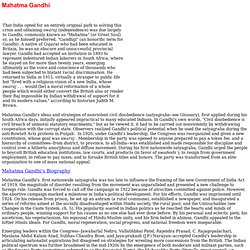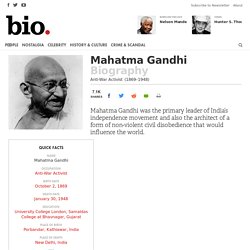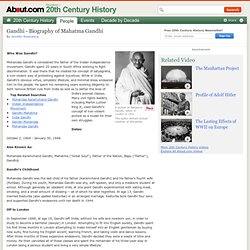

Mahatma Gandhi. Mahatma Gandhi Mahatma Gandhi's ideas and strategies of nonviolent civil disobedience (satyagraha--see Glossary), first applied during his South Africa days, initially appeared impractical to many educated Indians.

In Gandhi's own words, "Civil disobedience is civil breach of unmoral statutory enactments," but as he viewed it, it had to be carried out nonviolently by withdrawing cooperation with the corrupt state. Observers realized Gandhi's political potential when he used the satyagraha during the anti-Rowlatt Acts protests in Punjab. In 1920, under Gandhi's leadership, the Congress was reorganized and given a new constitution, whose goal was swaraj . Membership in the party was opened to anyone prepared to pay a token fee, and a hierarchy of committees--from district, to province, to all-India--was established and made responsible for discipline and control over a hitherto amorphous and diffuse movement. Foundation - Mahatma Gandhi Research and Media Service. Biography of Gandhi. Biography of M.K.

Gandhi A Child Groom The word Mahatma means great soul. This name was not given Gandhi at birth by his parents, but many years later by the Indian people when they discovered they had a Mahatma in their midst. Gandhi was born on October 2, 1869, in Porbandar, a small state in western India. Gandhi remembered his father as truthful, brave, incorruptible, and short-tempered, but he remembered his mother as a saint. At the age of six Gandhi went to school in Porbandar and had difficulty learning to multiply. When Gandhi was thirteen, he was married to Kasturbai, a girl of the same age.
At first the thirteen-year-old couple were almost too shy to speak to each other, but Gandhi soon became bossy and jealous. The young bridegroom was still in high school, where his scholarship had improved, and he won several small prizes. Gandhi’s family was sternly vegetarian, but the boy’s patriotism vanquished his scruples. Gandhi was sixteen when his father died. END OF PART ONEPart Two. Mahatma Gandhi Biography. Early Life Indian nationalist leader Mohandas Karamchand Gandhi, more commonly known as Mahatma Gandhi, was born on October 2, 1869, in Porbandar, Kathiawar, India, which was then part of the British Empire.

His father, Karamchand Gandhi, served as a chief minister in Porbandar and other states in western India. His mother, Putlibai, was a deeply religious woman who fasted regularly. Gandhi grew up worshiping the Hindu god Vishnu and following Jainism, a morally rigorous ancient Indian religion that espoused non-violence, fasting, meditation and vegetarianism.
Young Gandhi was a shy, unremarkable student who was so timid that he slept with the lights on even as a teenager. In 1885, Gandhi endured the passing of his father and shortly after that the death of his young baby. Spiritual/Political Leader and Humanitarian. At age 13, Gandhi joined Kasturba, age 12, in a marriage arranged by their parents.

The Gandhis had four sons: Harilal and Manilal, born in India, and Ramdas and Devdas born in South Africa. While Gandhi displayed loving kindness to everyone else, he was quite demanding and severe with his wife and sons. Use the links below to learn more about Gandhi's relationship with his family. Gandhi studied law in London and returned to India in 1891 to practice. In 1893 he accepted a one year contract to do legal work in South Africa. In 1915 Gandhi returned to India. India was granted independence in 1947, and partitioned into India and Pakistan. Among the tributes to Gandhi upon his death were these words by the great physicist, Albert Einstein: “Generations to come will scarce believe that such a one as this walked the earth in flesh and blood.”
Resource Menu. Gandhi - Biography of Mahatma Gandhi. Who Was Gandhi?

Mohandas Gandhi is considered the father of the Indian independence movement. Gandhi spent 20 years in South Africa working to fight discrimination. It was there that he created his concept of satyagraha, a non-violent way of protesting against injustices. While in India, Gandhi's obvious virtue, simplistic lifestyle, and minimal dress endeared him to the people. He spent his remaining years working diligently to both remove British rule from India as well as to better the lives of India's poorest classes. Dates: Gandhi Photos and Inspired Art. Dandi-march.
Gandhi Statue. Young Gandhi Portrait. Gandhi Statues. Gandhi Art portrait. Gandhi Inspired Art. Gandhi Speech. Mahatma Gandhi Talks- First Indian Talking Movie. Footage - Gandhi - 1930 April, #02. Footage - Gandhi - 1930 March 12, #01. Favorite Gandhi Quote #4. Favorite Gandhi Quote #3. Favorite Gandhi Quote #2. Favorite Gandhi Quote #1.